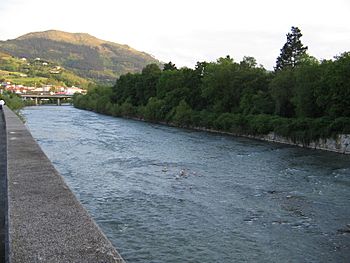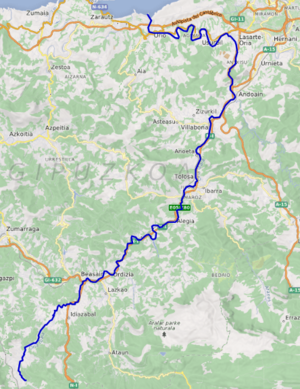Oria (river) facts for kids
Quick facts for kids Oria |
|
|---|---|

The Oria river on its way through Lasarte-Oria with mount Buruntza in the background
|
|
 |
|
| Country | Spain |
| Physical characteristics | |
| Main source | Basque Mountains |
| River mouth | Cantabrian Sea (Bay of Biscay) |
| Length | 75 km (47 mi) |
| Basin features | |
| Basin size | 882.5 km2 (340.7 sq mi) |
The Oria [ˈoɾja] is an important river located in the Basque Country, in northern Spain. It flows into the Bay of Biscay, which is part of the Atlantic Ocean. The Oria is the main river in the Gipuzkoa province. It is known for its size, being 75 kilometers (about 47 miles) long. The river's basin, which is the area of land that drains into it, covers 882.5 square kilometers (about 341 square miles).
Like many rivers in the Basque Country, the Oria flows from south to north. These rivers are usually quite short. The Oria starts high up in the mountains, at about 1,260 meters (4,134 feet) above sea level. As it gets closer to the sea, the ocean's tides can affect the river's water level all the way to Usurbil. In this lower part of the river, there used to be many marshy areas and wetlands along its banks. However, some of these areas have been drained over time to make space for farms and buildings.
Contents
The Oria River's Journey
The Oria river begins its journey in the southern part of Zegama, a town in the Basque Country. It starts near a small village called Otzaurte and close to the San Adrian tunnel. The river collects water from many small streams that flow down from the northeastern side of the Aizkorri mountain range. This means the Oria is formed by several streams joining together.
Towns Along the River
The first town the Oria river flows through is Zegama itself. As it continues its path, the river passes through many other important towns in Gipuzkoa. These include:
From Lasarte-Oria to Orio, a winding coastal road called N-634 follows the river's path. This road is often busy with traffic.
An Important Pathway
The Oria river is a very important part of the Gipuzkoa province. It acts like a central pathway for the region. A major road, the A-1 (which is also part of European routes E-5 and E-80), runs alongside the Oria for most of its length. The Spanish Northern Railway also follows the river, starting from its source in the Aizkorri mountains.
About 128,000 people live in the area that drains into the Oria river. Most of the flat areas along the river are heavily populated. However, the southernmost parts of the river's path, closer to its source, have fewer people living there.
River Health and Aquatic Life
For many years, starting in the mid-1800s, factories were built intensely along the banks of the Oria river. This caused a lot of pollution, and by the 1980s, almost all the animals living in the river had disappeared.
Improving Environmental Conditions
Luckily, things started to change in the 1980s. Efforts were made to clean up the river, and today, the Oria is much healthier. While there is still a small and sometimes unstable population of trout downstream of Andoain, other types of fish are doing well and their numbers are steady.
Fish Species in the Oria
Some of the fish that live in the Oria river include:
- Cyprinidae family fish, like the barbel (Barbus graellsi)
- Ezkailu (Phoxinus phoxinus)
- Ray-finned fish (Chondrostoma toxostoma arrigonis)
A special part of the river's mouth, near the village of Aginaga, is famous for its baby eels. These young eels are caught and harvested for food before they grow into adult eels. They are considered a very special and expensive food, even though they were not valued much just a few decades ago.
Main Rivers Joining the Oria
Several smaller streams and rivers flow into the Oria. The two most important rivers that join the Oria are:
- The Leitzaran river, which flows into the Oria in Andoain.
- The Araxes river, which joins the Oria in Tolosa.
See also
 In Spanish: Río Oria para niños
In Spanish: Río Oria para niños

